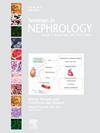The Human Burden of Mesoamerican Nephropathy: Diagnosis and Treatment in a Complex Web of Socioeconomics, Context, and Stigma
IF 3.5
3区 医学
Q2 UROLOGY & NEPHROLOGY
引用次数: 0
Abstract
Mesoamerican endemic nephropathy is a form of chronic kidney disease of still undetermined cause, highly prevalent in specific areas in and around the Mesoamerican region. Generic tubulointerstitial disease is found in kidney biopsies. Incidence and mortality are high in the hot spots. Most patients continue to be diagnosed only when dialysis treatment is urgently required, even though the disease has a fairly clear, identifiable clinical presentation. MeN is a diagnosis of exclusion, identified mostly in young male individuals from affected regions during screenings, after an acute kidney injury event, or after presenting with symptoms such as cramps, numbness, tingling, weakness, dysuria, or a history of "fever." Laboratory findings include hypokalemia, hyponatremia, hyperuricemia, and altered anion gap metabolic acidosis. Several risk factors have been hypothesized, though the cause (or causes) remains elusive. Many patients remain undiagnosed because of barriers to early diagnosis and treatment, mainly the lack of awareness of the disease among the population and health care personnel, the reliance on adapted kidney function thresholds, and the limited accessibility to standard diagnostic tests at the community level. On the other hand, coverage and treatment for those diagnosed early also need improvement because some of the treatment options empirically used are not routinely available at the primary health care level and have not been adequately validated. Another relevant barrier is the stigma surrounding the disease, with communities having been suffering from high death tolls for decades without relief or an end in sight. The dissemination of knowledge—about how the disease is suspected, diagnosed, and treated—and strengthening the local primary health care services adequately will bring hope to the affected communities, enhance opportunities for early diagnosis, and open the door to secondary prevention, ultimately reducing the incidence of dialysis and mortality.
中美洲肾病的人类负担:在社会经济、环境和污名的复杂网络中的诊断和治疗。
中美洲地方性肾病是一种病因不明的慢性肾脏疾病,在中美洲地区及其周围的特定地区高度流行。肾活检中可发现一般性小管间质性疾病。热点地区的发病率和死亡率都很高。大多数患者只有在迫切需要透析治疗时才会被诊断出来,即使该疾病具有相当明确、可识别的临床表现。男性是一种排除性诊断,主要在筛查期间、急性肾损伤事件后、或出现痉挛、麻木、刺痛、无力、排尿困难或“发热”史等症状后,在受影响地区的年轻男性个体中发现。实验室结果包括低钾血症、低钠血症、高尿酸血症和阴离子间隙改变代谢性酸中毒。几个风险因素已经被假设,尽管原因(或原因)仍然难以捉摸。由于早期诊断和治疗方面的障碍,许多患者仍未得到诊断,主要是人口和保健人员对该病缺乏认识,依赖于适应的肾功能阈值,以及在社区一级获得标准诊断测试的机会有限。另一方面,对早期诊断者的覆盖范围和治疗也需要改进,因为经验上使用的一些治疗方案在初级卫生保健一级并非常规可用,也没有得到充分验证。另一个相关障碍是围绕这种疾病的耻辱,社区几十年来一直遭受高死亡率的折磨,没有得到缓解,也看不到终结。传播关于该病如何被怀疑、诊断和治疗的知识,并充分加强地方初级卫生保健服务,将为受影响社区带来希望,增加早期诊断的机会,并为二级预防打开大门,最终减少透析发生率和死亡率。
本文章由计算机程序翻译,如有差异,请以英文原文为准。
求助全文
约1分钟内获得全文
求助全文
来源期刊

Seminars in nephrology
医学-泌尿学与肾脏学
CiteScore
5.60
自引率
0.00%
发文量
27
审稿时长
6-12 weeks
期刊介绍:
Seminars in Nephrology is a timely source for the publication of new concepts and research findings relevant to the clinical practice of nephrology. Each issue is an organized compendium of practical information that serves as a lasting reference for nephrologists, internists and physicians in training.
 求助内容:
求助内容: 应助结果提醒方式:
应助结果提醒方式:


